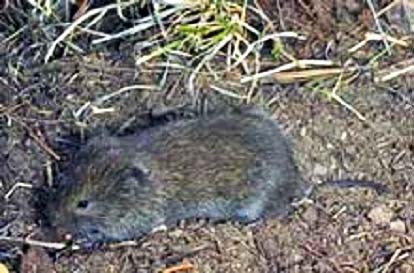Microtus longicaudus
Area of Distribution: Long-tailed voles are found throughout the western United States and Canada up through southeastern Alaska. Long-tailed voles occupy a variety of habitats, such as dry grassy areas, mountain slopes, forests, stream banks, sagebrush grasslands, mountain meadows, aspen woodlands, and riparian zones.
Above ground foraging Long-tailed Vole populations can be controlled using the Vole Control Bait Station System with the Tent Set-up Method.
 Long-tailed vole |
 Distribution of the Long-tailed vole |
| Pictures from - National Museum of Natural History ©2004 Smithsonian Institution | |
Physical characteristics: Long-tailed voles are small bodied with long, bicolor tails. The tail is about 30% of their total length. The fur color varies with the on its on its body. The back part of the voles fur is grayish brown with black tips, while the front fur is light gray color. They are typically larger than the montane or meadow voles. Total length is 7 to 8.4 inches, tail length is 2.2 to 3 inches, and they weigh 1.4 to 1.9 ounces.
Reproduction: The breeding season is from May to October and they may breed twice during this time. They have 3 to 6 young.
Ecology: This species does not form well-defined runways like the meadow and montane vole. The Long-tailed Vole feeds primarily on green plants when available, and on many underground fungi. It eats roots and bark when green vegetation is scarce. In winter, these voles spread out across the mountain slopes in search of food; in summer, they usually retreat into grassy areas. They are active all year long, and are primarily nocturnal. One way to reduce their numbers and prevent damage is to get rid of groundcover such as weeds and overgrown grasses. This limits their habitat and exposes them to predators. They will tend to avoid open areas. Their home ranges have been estimated to be about 0.6 acre for males and 0.5 acre for females.
Signs of Long-tailed Vole Activity: Their runways are 1 to 2 inches wide with matted grass along them that lead to burrows. The soil may be spongy under foot from their burrowing. Look for unhealthy plants that may be stressed from damage to the roots by these voles.